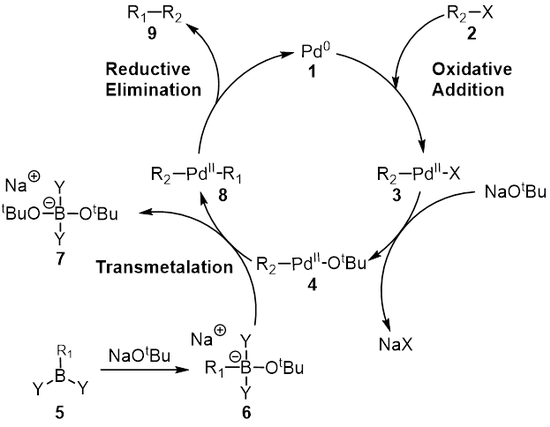Akira Suzuki
Akira Suzuki | |
|---|---|
Hokkaidō University | |
| Known for | Suzuki reaction |
| Awards |
|
| Scientific career | |
| Institutions | |
Akira Suzuki (鈴木 章, Suzuki Akira, born September 12, 1930) is a Japanese chemist and
Early life and education
Suzuki was born on September 12, 1930, in
Career
From 1963 until 1965, Suzuki worked as a postdoctoral student with

With his retirement from Hokudai in 1994 he took several positions in other universities: 1994–1995
In 2010, Suzuki was jointly awarded the Nobel Prize for Chemistry together with Richard F. Heck and Ei-ichi Negishi.[10]
To celebrate International Year of Chemistry (IYC 2011), Suzuki was interviewed by the UNESCO Courier magazine, he said:
Today some people see chemistry just as a polluting industry, but that is a mistake ... Without it, productivity would drop and we could not enjoy the life we know today. If there is pollution, it is because we are releasing harmful substances. Obviously, we have to adapt treatment and management regimes and work to develop chemical substances and manufacturing processes that respect the environment.[11]
In 2014, a Canadian-Chinese student asked for Suzuki's advice: "how can I become a great chemist like you?", Suzuki answered him: "... above all else, you must learn to see through the appearance to perceive the essence."
Invention without patent
Suzuki has not obtained a patent on Suzuki reaction technology because he thinks that the research was supported by government funds,[6] therefore coupling technology has become widespread, and many products using this technology have been put into practical use.[12] To date, there are more than 6,000 papers and patents related to Suzuki reaction.[6]
Recognition

- 1986 – Weissberger-Williams lectureship Award[13]
- 1987 – Korean Chemical Society Award
- 1989 – Chemical Society of Japan Award
- 1995 – DowElanco lectureship Award
- 2000 – The H. C. Brown Lecture Award
- 2003 – Japan Academy Prize
- 2009 – Paul Karrer Gold Medal
- 2009 – Special Member of Royal Society of Chemistry (RSC)
- 2010 – Nobel Prize in Chemistry
- 2010 – Order of Culture
- 2010 – Person of Cultural Merit
- 2011 – Member of the Japan Academy
- 2011 – honored on a stamp issued by Republic of the Congo[14]
- 2016 – Honorary chair professorship, National Cheng Kung University[15]
See also
- List of Japanese Nobel laureates
- Richard F. Heck
- Ei-ichi Negishi
- Makoto Kumada
- Kenkichi Sonogashira
References
- S2CID 53532765.
- ^ Miyaura, N.; Suzuki, A. Chem. Commun. 1979, 866.
- Pure Appl. Chem.1991, 63, 419–422. (Review)
- ^ Suzuki, A. J. Organometallic Chem. 1999, 576, 147–168. (Review)
- ^ 『朝日小学生新聞』2010年10月8日
- ^ a b c 『朝日新聞』2010年10月7日
- . 和書.
- ^ "鈴木 章 Akira Suzuki | Chem-Station (ケムステ)". www.chem-station.com. Retrieved March 20, 2022.
- S2CID 53050782.
- ^ "The Nobel Prize in Chemistry 2010" (Press release). Royal Swedish Academy of Sciences. October 6, 2010. Retrieved October 6, 2010.
- ^ "Letter to a young chemist" (PDF). The UNESCO Courier. 2011. pp. 39–41.
- ^ "根岸・鈴木氏、特許取得せず…栄誉の道開く一因". 読売新聞. October 7, 2010. Archived from the original on October 9, 2010. Retrieved October 8, 2010.
- ^ Akira Suzuki (in Japanese)
- ^ Akira Suzuki editorial photo. Image of discovery, historic – 96887166
- ^ "Nobel laureate Akira Suzuki receives honorary chair professorship from NCKU – NCKU, 國立成功大學 National Cheng Kung University". Archived from the original on September 27, 2017. Retrieved September 27, 2017.
External links
- Akira Suzuki "Letter to a young chemist" in The UNESCO Courier, "CHEMISTRY AND LIFE", January–March 2011
- Akira Suzuki on Nobelprize.org
- The Nobel Prize in Chemistry 2010 Richard F. Heck, Ei-ichi Negishi, Akira Suzuki press release
- Akira Suzuki

